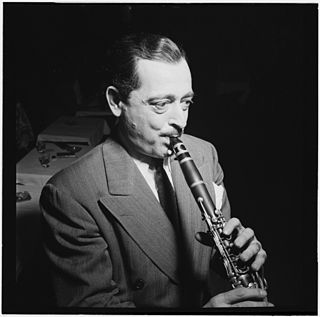
Albert Edwin "Eddie" Condon was an American jazz banjoist, guitarist, and bandleader. A leading figure in Chicago jazz, he also played piano and sang.
Jazzology Records is an American jazz record company and label. It is part of the Jazzology group of labels owned and operated by the George H. Buck Jr. Jazz Foundation.
Benjamin "Buzzy" Drootin was a jazz drummer. He played with many leading jazz musicians over a career of sixty years.

Howard Vincent Alden is an American jazz guitarist born in Newport Beach, California. Alden has recorded many albums for Concord Records, including four with seven-string guitar innovator George Van Eps.

Jack Lesberg was a jazz double-bassist.

Robert Sage Wilber was an American jazz clarinetist, saxophonist, and band leader. Although his scope covers a wide range of jazz, Wilber was a dedicated advocate of classic styles, working throughout his career to present traditional jazz pieces in a contemporary manner. He played with many distinguished jazz leaders in the 1950s and 1960s, including Bobby Hackett, Benny Goodman, Sidney Bechet, Jack Teagarden and Eddie Condon. In the late 1960s, he was an original member of the World's Greatest Jazz Band, and in the early 70s of Soprano Summit, a band which gained wide attention. In the late 1970s, he formed the Bechet Legacy Band.
Victor Dickenson was an American jazz trombonist. His career began in the 1920s and continued through musical partnerships with Count Basie (1940–41), Sidney Bechet (1941), and Earl Hines.
Ralph Earl Sutton was an American jazz pianist born in Hamburg, Missouri. He was a stride pianist in the tradition of James P. Johnson and Fats Waller.

Edmond Hall was an American jazz clarinetist and bandleader. Over his long career Hall worked extensively with many top performers as both a sideman and bandleader and is perhaps best known for the 1941 chamber jazz song "Profoundly Blue," which is regarded as a pre-World War II jazz classic.

William Orval Crow is an American jazz bassist. Among other work, Crow was the long-term bassist in saxophonist Gerry Mulligan's bands in the 1950s and 1960s.
Martin Oliver Grosz is an American jazz guitarist, banjoist, vocalist, and composer born in Berlin, Germany. He performed with Bob Wilber and wrote arrangements for him. He has also worked with Kenny Davern, Dick Sudhalter, and Keith Ingham.

Tony Parenti was an American jazz clarinettist and saxophonist born in New Orleans. After starting his musical career in New Orleans, he had a successful career in music in New York City for decades.
Leonard Gaskin was an American jazz bassist born in New York City.
Big Chief Russell Moore was an American jazz trombonist.
Richard MacQueen "Dick" Wellstood was an American jazz pianist.
Ed Polcer is an American jazz cornetist, bandleader, festival director, club owner, and mentor of young musicians. He has been described as a "melodic mellow-toned cornetist with an unforced delivery". Polcer started leading jazz bands while attending Princeton University. While at Princeton studying engineering, he was headed toward a promising career as a professional baseball player. During that time, he was asked to play at the wedding of Princess Grace and Prince Rainier in Monaco, as well as a concert in Carnegie Hall. He chose music over baseball.
Dick Cary was an American jazz trumpeter, composer and arranger.
Chiaroscuro Records is a jazz record company and label founded by Hank O'Neal in 1970. The label's name comes from the art term for the use of light and dark in a painting. O'Neal got the name from his friend and mentor Eddie Condon, a jazz musician who played in what were called Chiaroscuro Concerts in the 1930s. O'Neal also got the name from a store that sold only black and white dresses.
The George H. Buck Jr. Jazz Foundation was created by George Buck in the 1980s to maintain the catalog of his jazz record labels. The catalog includes dixieland jazz, swing, blues, rhythm and blues, gospel, and cabaret music.
Warren W. Vaché Sr. was an American jazz musician and journalist. He was the father of jazz musician and trumpet player Warren Vaché Jr. and clarinet player Allan Vache.







